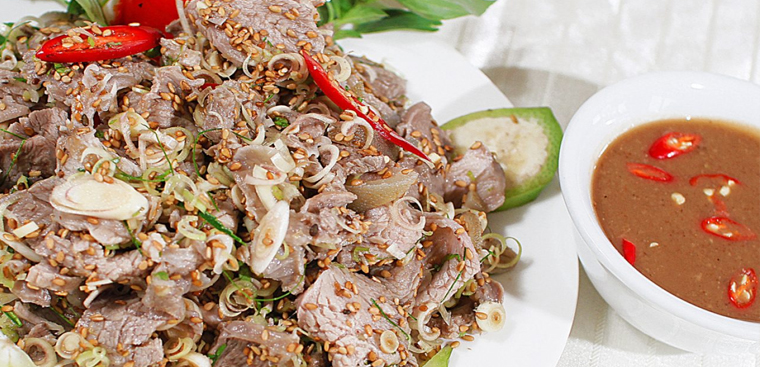Introduction
Vietnam is renowned for its vibrant and diverse culinary heritage. From the bustling streets of Hanoi to the serene countryside of the Mekong Delta, Vietnamese cuisine offers a plethora of flavors and textures that captivate food enthusiasts worldwide. Among the myriad of dishes, “De Tai Chanh” or “Rare Goat Meat with Lemon” stands out as a unique and delectable specialty. This dish embodies the essence of Vietnamese cooking—fresh, flavorful, and deeply rooted in tradition.

The Origins of De Tai Chanh
“De Tai Chanh” originates from the northern regions of Vietnam, particularly in areas where goat farming is prevalent. The dish has been a part of Vietnamese culinary culture for centuries, often enjoyed during special occasions and family gatherings. Goat meat, known for its tenderness and distinct flavor, is a staple in these regions, and “De Tai Chanh” is one of the most celebrated ways to prepare it.
The Ingredients
The charm of “De Tai Chanh” lies in its simplicity and the use of fresh, high-quality ingredients. Here’s a breakdown of what you’ll need to prepare this dish:
1. Goat Meat: The star of the dish, preferably from a young goat for its tenderness. The meat is often sliced thinly to absorb the flavors better.
2. Lemon or Lime: Fresh lemon or lime juice is essential for marinating the goat meat, giving it a zesty and tangy flavor.
3. Galangal: A root similar to ginger but with a more citrusy flavor, galangal adds a unique depth to the dish.
4. Garlic and Shallots: These aromatics provide a robust base flavor.
5. Fresh Herbs: Vietnamese dishes are incomplete without a generous handful of fresh herbs like mint, cilantro, and basil.
6. Chilies: For those who love a bit of heat, fresh red chilies are a must.
7. Fish Sauce: A staple in Vietnamese cooking, fish sauce adds a savory umami flavor.
8. Roasted Peanuts: These add a delightful crunch and nuttiness to the dish.

Preparation Method
Creating “De Tai Chanh” is an art that requires patience and precision. Here’s a step-by-step guide to preparing this exquisite dish:
1. Preparing the Meat: Start by slicing the goat meat thinly against the grain. This helps in making the meat tender and easier to chew. If the meat is particularly tough, you can lightly pound it with a meat mallet.
2. Marinating: In a bowl, combine the sliced meat with lemon or lime juice. The acidity from the citrus will “cook” the meat slightly, similar to how ceviche is prepared. Add finely chopped galangal, garlic, and shallots to the mixture. Season with fish sauce and a pinch of sugar. Let the meat marinate for at least 30 minutes, allowing the flavors to meld together.
3. Herbs and Chilies: While the meat is marinating, prepare the fresh herbs. Roughly chop the mint, cilantro, and basil. Slice the chilies thinly. These will be mixed with the meat just before serving to maintain their freshness.
4. Assembly: After the meat has marinated, mix in the fresh herbs and chilies. Toss everything together gently to ensure even distribution. Taste and adjust seasoning if necessary.
5. Serving: “De Tai Chanh” is typically served as an appetizer or a main dish. Arrange the meat mixture on a platter and garnish with roasted peanuts for an added crunch. It’s best enjoyed with a side of fresh vegetables like cucumber, lettuce, and pickled carrots.

Nutritional Benefits
Goat meat is a healthy alternative to more commonly consumed meats like beef or pork. It is lower in calories, fat, and cholesterol, making it a heart-healthy option. Additionally, goat meat is rich in iron, protein, and essential vitamins, making “De Tai Chanh” not only delicious but also nutritious.
Cultural Significance
In Vietnamese culture, food is a means of bringing people together. “De Tai Chanh” is often enjoyed during communal meals, where families and friends gather to share food and stories. The dish is a testament to the Vietnamese way of using simple, fresh ingredients to create something truly extraordinary.
Pairing Suggestions
“De Tai Chanh” pairs beautifully with a variety of Vietnamese sides and beverages:
1. Rice Paper Rolls: These fresh rolls filled with vegetables, herbs, and sometimes shrimp or pork, complement the flavors of “De Tai Chanh.”
2. Banh Xeo: A crispy Vietnamese pancake, often served with fresh herbs and a dipping sauce, makes a great accompaniment.
3. Vietnamese Beer: A cold glass of Saigon or Hanoi beer is perfect for washing down the tangy, savory flavors of the dish.
4. Herbal Tea: For a non-alcoholic option, a pot of fragrant jasmine or lotus tea enhances the dining experience.
Variations
While the traditional “De Tai Chanh” recipe is cherished, there are several regional variations and personal twists that you can explore:
1. Spicy Version: Increase the number of chilies in the marinade for a spicier kick.
2. Nutty Twist: Add a spoonful of peanut butter to the marinade for a richer, nutty flavor.
3. Vegetable Additions: Incorporate thinly sliced vegetables like bell peppers or carrots for added texture and color.

Conclusion
“De Tai Chanh” is a culinary gem that encapsulates the essence of Vietnamese cuisine—fresh, flavorful, and deeply satisfying. Whether you are a seasoned chef or a home cook looking to explore new flavors, this dish offers a delightful journey into the heart of Vietnamese cooking. By following the steps and embracing the cultural significance of “De Tai Chanh,” you can bring a piece of Vietnam to your dining table. Enjoy this exquisite dish with loved ones and create memorable culinary experiences.










